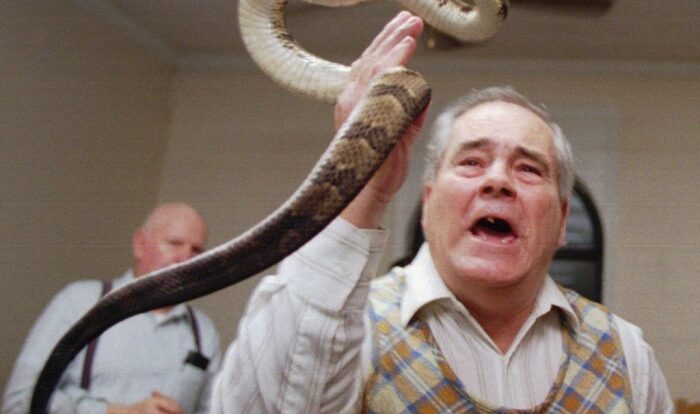
In the realm of pet ownership, few combinations are as unexpected and potentially heartwarming as that of a snake named Yumi and a cat named Kitty. This guide will delve into the intricacies of how to handle his snake yumi sin and fit kitty, ensuring a harmonious and fulfilling coexistence for both animals and their human companions.
We’ll explore the nuances of snake handling, from proper holding techniques to recognizing body language and avoiding bites. We’ll also discuss the potential risks and benefits of introducing a snake to a household with a cat, providing strategies for gradual introductions and creating a safe environment for both animals.
Snake Handling Techniques: How To Handle His Snake Yumi Sin And Fit Kitty

Handling a snake requires caution and proper technique to ensure the safety of both the handler and the snake. Yumi, the snake in question, is a non-venomous species, but it’s essential to approach any snake handling with respect and care.
Holding Techniques
- Support the snake’s body:Use both hands to gently support the snake’s body, with one hand near the head and the other supporting the tail.
- Avoid sudden movements:Snakes are sensitive to sudden movements, so move slowly and calmly when handling them.
- Keep the snake away from your face:Always keep the snake’s head away from your face to prevent bites.
Avoiding Bites
- Respect the snake’s space:Never approach a snake without first giving it space to retreat.
- Recognize warning signs:Snakes may exhibit defensive behaviors such as hissing, coiling, or flattening their bodies. If you see these signs, back away slowly.
- Avoid handling snakes during feeding:Snakes are more likely to bite when they are hungry.
Emergency Procedures
In the unlikely event of a bite, remain calm and follow these steps:
- Wash the wound:Clean the wound thoroughly with soap and water.
- Seek medical attention:Even if the snake is non-venomous, it’s important to seek medical attention to prevent infection.
- Identify the snake:If possible, take a photo or note the snake’s appearance for identification.
Cat-Snake Compatibility

Introducing a snake into a household with a cat named “Kitty” requires careful consideration, as it can pose potential risks and benefits. Understanding the unique characteristics and behaviors of both species is crucial for ensuring a harmonious and safe environment.
One of the primary concerns is the predatory instincts of cats. Snakes, being natural prey for felines, may trigger Kitty’s hunting response. This can lead to aggressive behavior, injury, or even death for the snake. Conversely, a snake’s defensive mechanisms, such as venom or constriction, can pose a threat to Kitty if she attempts to attack or play with it.
It’s essential to master the techniques for handling his snake yumi sin and fit kitty. The same principles apply to boosting insurance agent productivity. Read here to discover strategies for enhancing productivity. Once you’ve mastered these skills, you’ll be well-equipped to effectively handle both your snake and insurance clients.
Gradual Introductions and Supervised Interactions
To mitigate these risks, it is essential to introduce the snake and Kitty gradually and under strict supervision. This involves keeping them in separate enclosures initially and allowing them to become familiar with each other’s scents and presence from a distance.
Over time, supervised interactions can be introduced, with Kitty on a leash or harness to prevent any sudden movements that might startle the snake.
Creating a Safe Environment, How to handle his snake yumi sin and fit kitty
Creating a safe environment for both animals is paramount. Provide ample hiding places and vertical space for the snake, allowing it to escape potential confrontations with Kitty. Ensure the snake’s enclosure is secure and escape-proof, preventing Kitty from accessing it.
Handling a snake and a cat can be tricky, but it’s important to know how to do it safely. If you’re not sure how to handle your snake, this article can help. It provides step-by-step instructions on how to pick up, hold, and feed your snake.
You’ll also learn how to handle your snake if it becomes aggressive.
Additionally, remove any potential triggers that might incite Kitty’s predatory instincts, such as toys or objects that resemble snakes.
Monitoring Body Language and Preventing Territorial Disputes
Monitoring body language is crucial to prevent territorial disputes. Signs of stress or aggression in either animal, such as hissing, tail flicking, or dilated pupils, should be addressed immediately. Separate them if necessary and provide a safe space for each to retreat.
Consistency in feeding and care routines can also help minimize competition and potential conflicts.
I’m handling his snake yumi sin and fit kitty. Meanwhile, insurance agents can boost productivity by following these tips: how to increase insurance agent productivity . I’m returning to my snake yumi sin and fit kitty now.
Diet and Nutrition for Yumi and Kitty
Maintaining a balanced and nutritious diet is crucial for the well-being of both Yumi the snake and Kitty the cat. Understanding their specific dietary needs and following appropriate feeding practices is essential for their health and longevity.
Yumi, as a snake, is a carnivorous reptile with a unique digestive system. Her diet primarily consists of live or frozen rodents, such as mice or rats. The size and frequency of feeding depend on her age, size, and activity level.
It’s important to avoid overfeeding, as obesity can lead to health problems.
Feeding Schedule and Portion Sizes
- For young snakes like Yumi, feeding once every 5-7 days is recommended.
- As she grows, the frequency can be reduced to once every 10-14 days.
- The portion size should be approximately 10-15% of her body weight.
- Avoid handling Yumi for at least 24 hours after feeding to allow for proper digestion.
Kitty, on the other hand, is an obligate carnivore and requires a diet rich in animal-based protein. High-quality commercial cat food formulated for her age and activity level is the most convenient and balanced option. Wet food provides additional moisture, while dry food promotes dental health.
Feeding Schedule and Portion Sizes
- Adult cats typically require two meals per day.
- Kittens and pregnant/nursing cats may need more frequent feedings.
- The portion size should be adjusted based on Kitty’s weight, age, and activity level, following the manufacturer’s guidelines.
- Avoid overfeeding, as obesity can lead to health issues such as diabetes and joint problems.
Improper nutrition can have severe consequences for both Yumi and Kitty. For Yumi, an inadequate diet can lead to malnutrition, growth problems, and digestive issues. For Kitty, an unbalanced diet can cause weight problems, skin and coat issues, and urinary tract infections.
Enrichment and Stimulation
Providing a stimulating and enriching environment is crucial for the physical and cognitive well-being of Yumi and Kitty. Designing an enrichment plan that includes interactive toys, hiding spots, and mental stimulation will help keep them active, engaged, and happy.
If I could handle his snake Yumi Sin and fit kitty, I should have been able to scale any sales target. Insurance agents may not face off against the undead like me, but they could always learn from my strategies for dominating the lanes and keeping the enemy team on their toes.
Check out this guide on how to increase insurance agent productivity and you’ll soon be making enemy agents rage quit in frustration.
Interactive Toys
- Puzzle feeders: These toys require animals to solve puzzles to access treats, stimulating their problem-solving abilities.
- Interactive wands: These toys allow for interactive play between you and your pets, providing physical exercise and mental stimulation.
- Laser pointers: While not suitable as the sole source of exercise, laser pointers can provide short bursts of high-energy play.
Hiding Spots
Hiding spots provide a sense of security and comfort for both Yumi and Kitty. Consider providing:
- Cardboard boxes with multiple entrances
- Tunnels made of fabric or PVC
- Cat trees with enclosed spaces
Mental Stimulation
- Training: Teach Yumi and Kitty tricks or commands, which provides mental stimulation and strengthens your bond.
- Foraging: Hide treats or food around the enclosure, encouraging them to search and explore.
- Novel objects: Introducing new toys or objects into their environment provides mental stimulation and keeps them interested.
Health and Veterinary Care

Maintaining the well-being of your snake (Yumi) and cat (Kitty) is paramount. This guide will provide insights into the common health issues that can affect them, their symptoms, diagnosis, and treatment options. Regular veterinary checkups and preventative care are crucial for ensuring their optimal health.
Veterinary care for snakes and cats requires specialized knowledge. Exotic animal veterinarians have expertise in diagnosing and treating the unique health concerns of these species. Regular checkups allow for early detection and intervention of potential health issues.
Common Health Issues in Snakes (Yumi)
Snakes, like other animals, are susceptible to various health conditions. Understanding these issues is crucial for providing appropriate care.
- Respiratory Infections:Snakes can develop respiratory infections caused by bacteria, viruses, or fungi. Symptoms include wheezing, coughing, and nasal discharge.
- Skin Infections:Bacterial or fungal skin infections can cause lesions, scales, or blisters. Prompt treatment is necessary to prevent further complications.
- Parasites:Snakes can harbor internal or external parasites, such as mites or worms. These parasites can cause weight loss, lethargy, and digestive issues.
- Metabolic Bone Disease:Inadequate calcium intake or absorption can lead to metabolic bone disease, weakening bones and predisposing snakes to fractures.
- Dysecdysis:Difficulty shedding skin can occur due to various factors, including dehydration or underlying health issues.
Common Health Issues in Cats (Kitty)
Cats are prone to a range of health conditions, from minor ailments to more serious diseases. Awareness of these issues is essential for responsible cat ownership.
- Upper Respiratory Infections:Feline upper respiratory infections, often caused by viruses, can lead to sneezing, nasal discharge, and conjunctivitis.
- Gastrointestinal Issues:Cats may experience digestive problems such as vomiting, diarrhea, or constipation. These can be caused by dietary indiscretion, infections, or underlying diseases.
- Skin Allergies:Cats can develop allergies to various substances, including food, environmental allergens, or fleas. Symptoms include itching, scratching, and skin irritation.
- Dental Disease:Dental issues, such as gingivitis or periodontitis, can cause pain, bad breath, and tooth loss.
- Feline Leukemia Virus (FeLV):FeLV is a contagious virus that can lead to a weakened immune system and an increased risk of infections and certain types of cancer.
Outcome Summary
With careful planning, patience, and a deep understanding of the needs of both species, it is possible to create a harmonious household where Yumi the snake and Kitty the cat can thrive side by side. Remember to prioritize their safety, provide adequate enrichment, and seek professional veterinary care when needed.
By following the guidance Artikeld in this guide, you can ensure that your furry and scaly companions live long and happy lives together.
FAQ Guide
Can snakes and cats ever become friends?
While true friendship between a snake and a cat is unlikely, it is possible for them to coexist peacefully in the same household with proper supervision and management.
What is the best way to introduce a snake to a cat?
Introduce them gradually in a controlled environment, starting with brief supervised interactions and gradually increasing the duration and frequency of their encounters.
What are the signs of aggression in snakes?
Striking, hissing, flattening of the head, and coiling are all signs of aggression in snakes. If you observe any of these behaviors, it’s important to separate the animals immediately.





